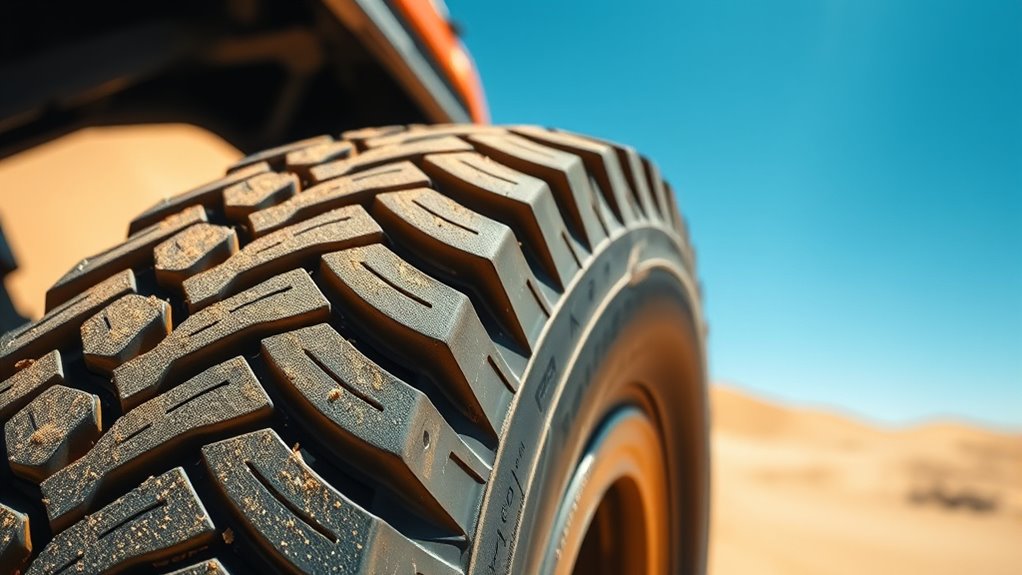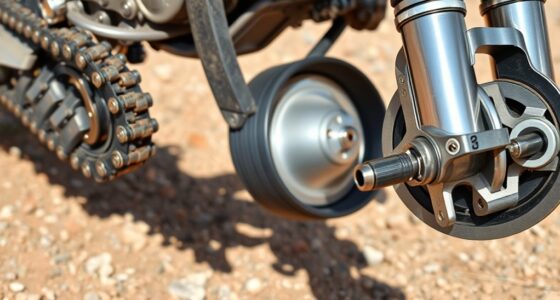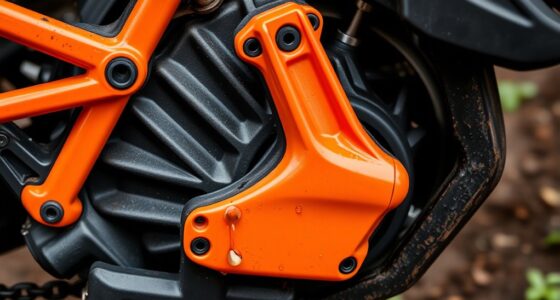For high-speed desert runs, you should fine-tune your tire pressure based on terrain, load, and temperature. Generally, lower pressures (around 15-20 psi) improve traction in soft sand or dunes, while firmer surfaces need higher pressures (30-35 psi). Always check tire pressure when cold and adjust gradually to stay within safe limits. Maintaining the right pressure enhances grip, safety, and performance—if you want to unleash more tips, keep exploring.
Key Takeaways
- Adjust tire pressure based on terrain: lower for soft sand and dunes, higher for rocky or firm surfaces.
- Maintain proper pressure to optimize grip, handling, and safety at high speeds during desert runs.
- Monitor temperature fluctuations, reducing pressure at night and increasing during daytime heating.
- Use precise tools like digital gauges and portable compressors for accurate, incremental adjustments.
- Follow manufacturer guidelines and vehicle-specific recommendations to prevent tire damage and ensure safety.
Understanding the Impact of Tire Pressure on Performance
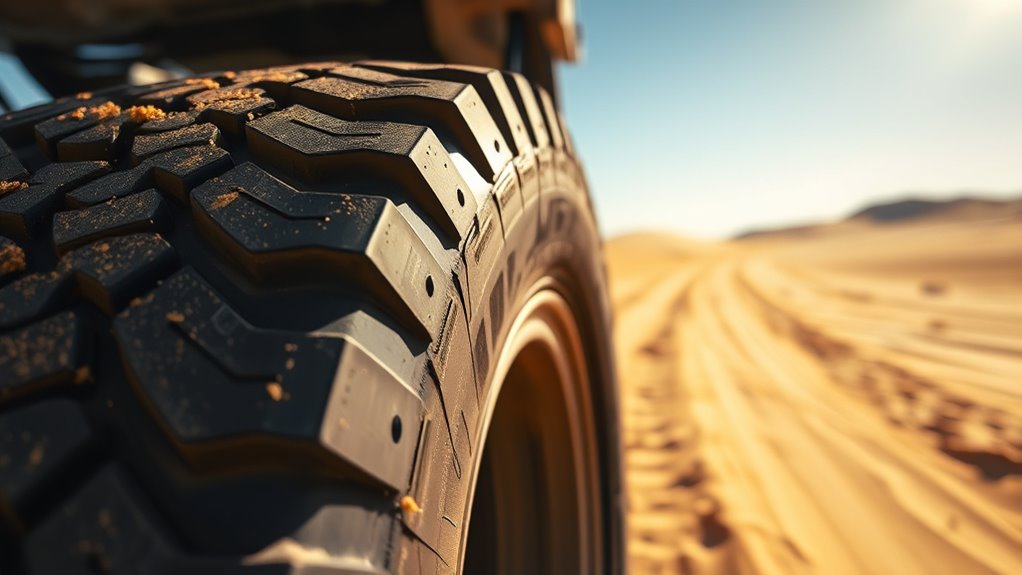
Proper tire pressure is critical because it directly influences your vehicle’s handling, fuel efficiency, and safety. When your tires are at the right pressure, they provide better grip, making your car more responsive on the road. Underinflated tires increase rolling resistance, causing your engine to work harder and consume more fuel. They also create a larger contact patch, which can lead to uneven wear and a higher risk of blowouts. Overinflated tires, on the other hand, reduce traction by decreasing the contact area with the road, making your driving less stable. Maintaining ideal tire pressure ensures even wear, better control, and improved safety, especially when pushing your vehicle to high speeds across challenging terrains like deserts. Proper pressure is essential for peak performance and safety. Understanding tire pressure helps optimize your vehicle’s overall performance and longevity.
Factors Influencing Optimal Tire Pressure in Desert Conditions
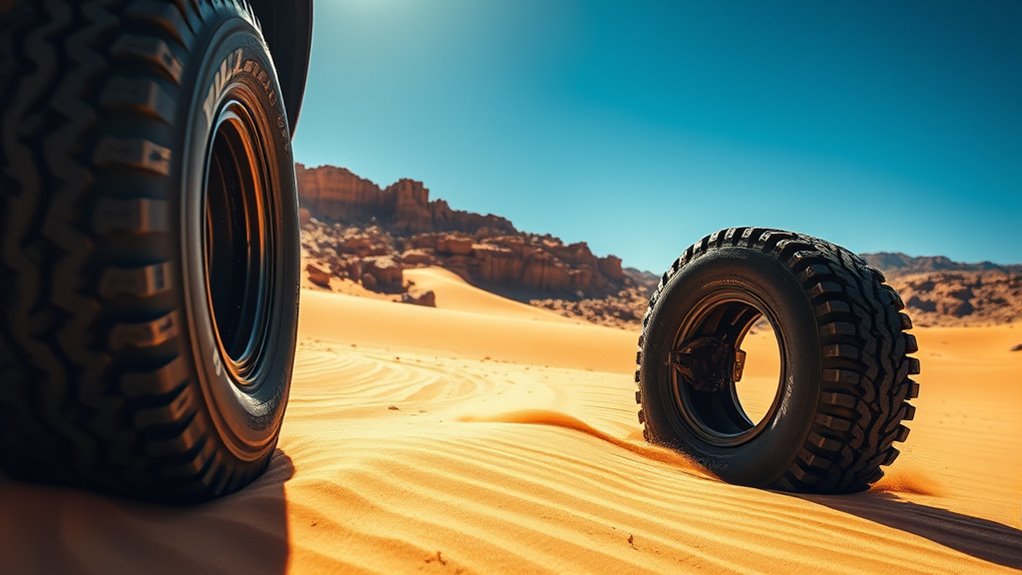
In desert conditions, the terrain you drive on can greatly affect the ideal tire pressure. Loose sand or rocky surfaces require adjustments to maintain traction and avoid damage. Additionally, temperature fluctuations can cause tires to expand or contract, influencing the optimal pressure you should set. For high-speed desert runs, maintaining the correct tire pressure is crucial to prevent tire deformation and ensure safety. Properly calibrated pressures can also improve the vehicle’s handling performance on challenging surfaces, especially when considering high-performance tire technology.
Terrain Composition Effects
Since desert terrains vary widely in composition, understanding how these differences impact tire pressure is vital for peak performance. Soft, sandy areas require lower tire pressures to increase the tire’s footprint, preventing sinking and improving traction. Conversely, firm, rocky surfaces demand slightly higher pressures to avoid tire damage and maintain stability. Loose gravel or dune terrains also benefit from reduced pressures, which help tires conform to uneven surfaces and enhance grip. However, over-deflating can cause tire bead unseating or sidewall damage, especially on sharp rocks. By evaluating terrain type—whether it’s loose sand, compacted gravel, or rocky outcrops—you can adjust your pressure accordingly. Tailoring tire pressure to terrain composition ensures ideal traction, stability, and safety during high-speed desert runs. Additionally, considering the bed material and its impact on tire deformation can further optimize performance and reduce tire wear during demanding desert conditions.
Temperature Fluctuations Impact
Temperature fluctuations in desert environments can substantially influence your tire pressure. As the sun rises and heats the air, your tires expand, increasing pressure. Conversely, at night, cooling causes pressure to drop. These shifts happen quickly and can affect handling, traction, and tire wear if not managed properly. You need to monitor your tire pressure regularly, especially during extended high-speed runs. Adjustments may be necessary to maintain ideal pressure, ensuring the tires stay in the safe and efficient range. Ignoring temperature impacts can lead to underinflation or overinflation, risking tire damage or reduced performance. Being aware of seasonal changes and their effects on tire pressure is crucial for optimal performance. By understanding how temperature swings affect your tires, you can better anticipate necessary pressure adjustments, helping you stay safe and maximize your desert running experience.
Recommended Tire Pressure Ranges for Different Vehicle Types
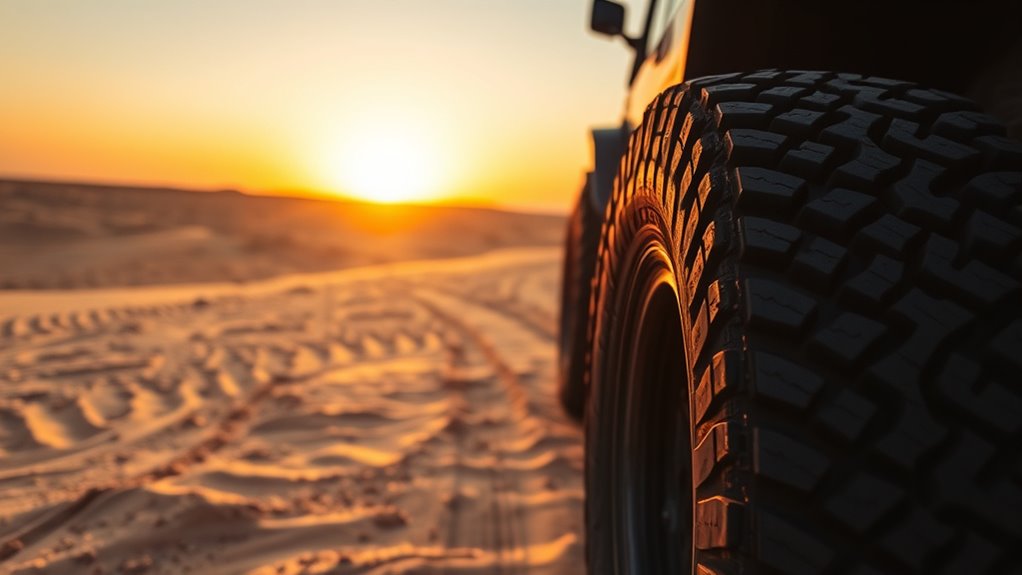
Have you ever wondered why tire pressure recommendations vary between vehicle types? Different vehicles have unique weight distributions, tire sizes, and suspension setups, which influence ideal pressures. For passenger cars, the recommended range usually falls between 30 and 35 psi, providing a balance of comfort and fuel efficiency. SUVs and trucks often require higher pressures—around 35 to 45 psi—to support heavier loads and improve handling. Race cars or high-performance vehicles typically need even higher pressures for stability at speed, sometimes exceeding 40 psi. Off-road or desert vehicles might have lower pressures for better traction, but these are still tailored to vehicle specifications. Always check your manufacturer’s guidelines for the precise recommended range to ensure safety and maximum performance during high-speed desert runs. Adjusting tire pressure based on cushioning and traction needs can further optimize performance in challenging terrains.
Adjusting Tire Pressure Based on Load and Speed
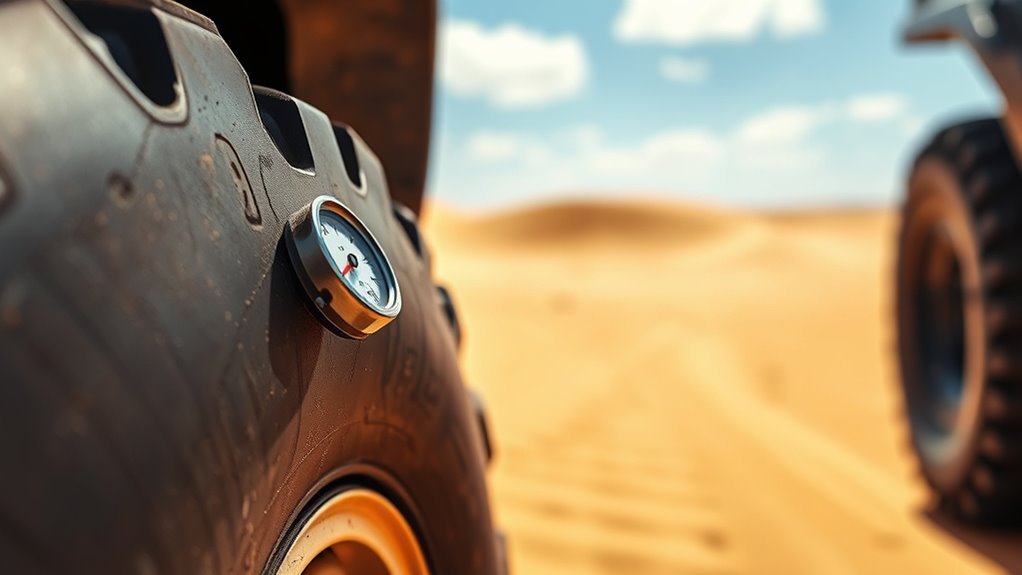
Your tire pressure needs to change depending on how much weight you’re carrying and how fast you’re driving. Heavier loads require higher pressures to prevent tire wear and improve safety, while speed can affect tire heat and performance. Adjusting your pressures accordingly helps guarantee ideal handling and longevity. For instance, proper tire tuning can enhance overall driving experience and safety during high-speed desert runs.
Load-Dependent Pressure Adjustments
Adjusting tire pressure based on load and speed is essential for maintaining peak handling and safety. When carrying heavier loads, increasing tire pressure helps prevent excessive flex and heat buildup, ensuring stability. Conversely, lighter loads allow for lower pressures to maximize grip. Here’s a quick guide:
| Load (lbs) | Recommended Pressure (psi) | Notes |
|---|---|---|
| Light | 15–20 | Max grip, lower heat |
| Moderate | 20–25 | Balanced performance |
| Heavy | 25–30 | Prevents tire sag |
Adjusting pressures according to load guarantees ideal contact patch and reduces tire wear. Always monitor tire temperatures and pressures regularly to maintain safety during high‑speed desert runs. Proper tire pressure management is also important for Honda Tuning enthusiasts seeking optimal vehicle performance.
Speed’s Impact on Tire
When considering how load influences tire pressure, adding speed introduces another layer of complexity. As you increase your speed, heat builds up inside the tire, causing the air to expand and pressure to rise. If your tires aren’t properly adjusted, this can lead to overinflation, reducing grip and risking blowouts. Conversely, at lower pressures, high speeds can cause excessive heat buildup, damaging the tire or compromising performance. To manage this, you need to balance tire pressure carefully based on both load and speed. Generally, higher speeds require slightly higher pressures to prevent heat-related failures. Keeping an eye on tire pressure regulation is essential when riding at high speeds. Always monitor your tire’s condition and adjust pressures accordingly, especially when pushing your vehicle in high-speed desert conditions.
Techniques for Measuring and Maintaining Correct Tire Pressures
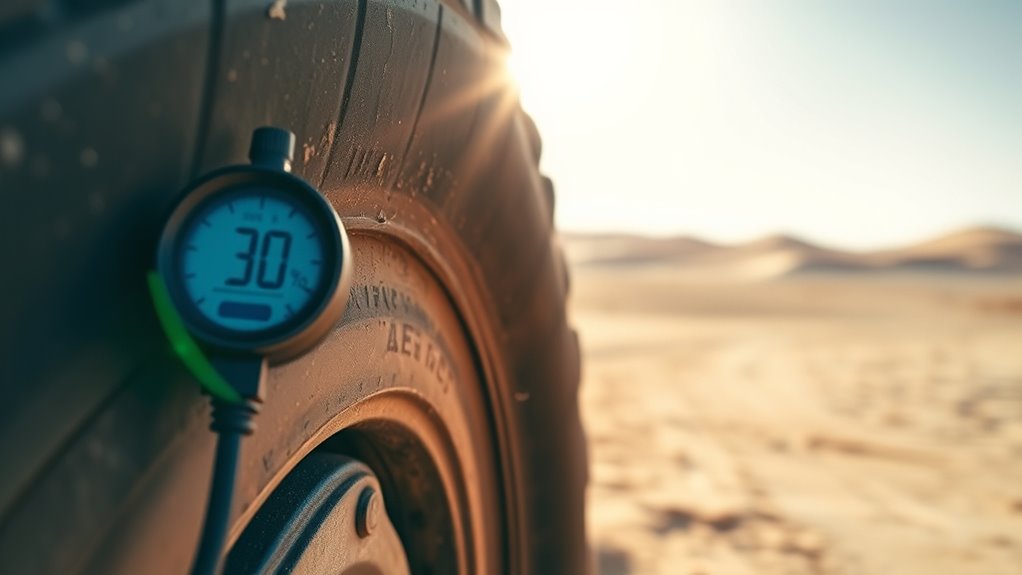
Ever wonder how to guarantee your tires are always at the right pressure? The key is using a quality digital or analog tire pressure gauge. Before heading out, check your tire pressures when tires are cold for an accurate reading. Always compare the readings to the recommended pressures found in your vehicle’s manual or on the tire placard. To maintain proper pressure, check it regularly during your trip, especially after rough terrain or long stretches. Use an air compressor or portable pump to add air as needed. Confirm you’re tightening the valve stem cap securely to prevent leaks. Consistent monitoring and adjusting help you keep your tires optimized for high-speed desert runs, improving safety, performance, and tire longevity. Additionally, understanding your vehicle’s specifications and how they influence optimal tire pressures can further enhance your driving experience.
Effects of Too Low or Too High Tire Pressures at High Speeds
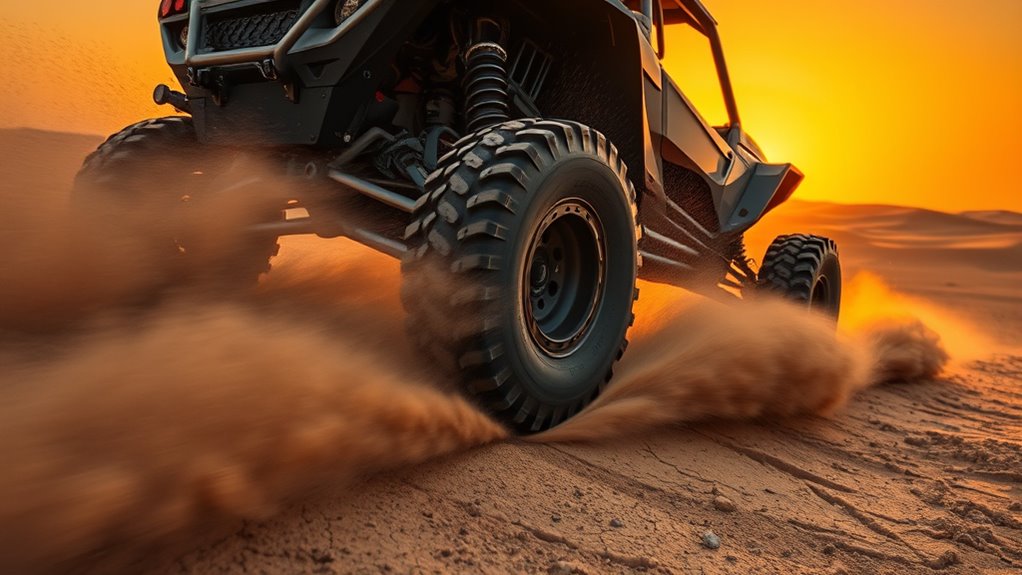
Exposing your tires to high speeds with incorrect pressure can substantially impact vehicle handling and safety. If your tire pressure is too low, your tires may flex excessively, causing poor stability, increased heat buildup, and a higher risk of blowouts. You’ll notice a softer ride but reduced control, especially on loose or uneven surfaces. Conversely, overly high pressures make tires stiffer, decreasing traction and absorbing less shock. This can lead to a harsher ride, reduced grip, and faster tire wear. At high speeds, these issues become more pronounced, risking loss of control or tire failure. Maintaining the correct pressure ensures ideal contact patch, stability, and safety. Always check and adjust your tires before high-speed desert runs to avoid these dangerous effects. Regularly monitoring tire pressure with a reliable gauge helps maintain optimal conditions and enhances overall performance.
Tools and Equipment for Accurate Tire Pressure Management
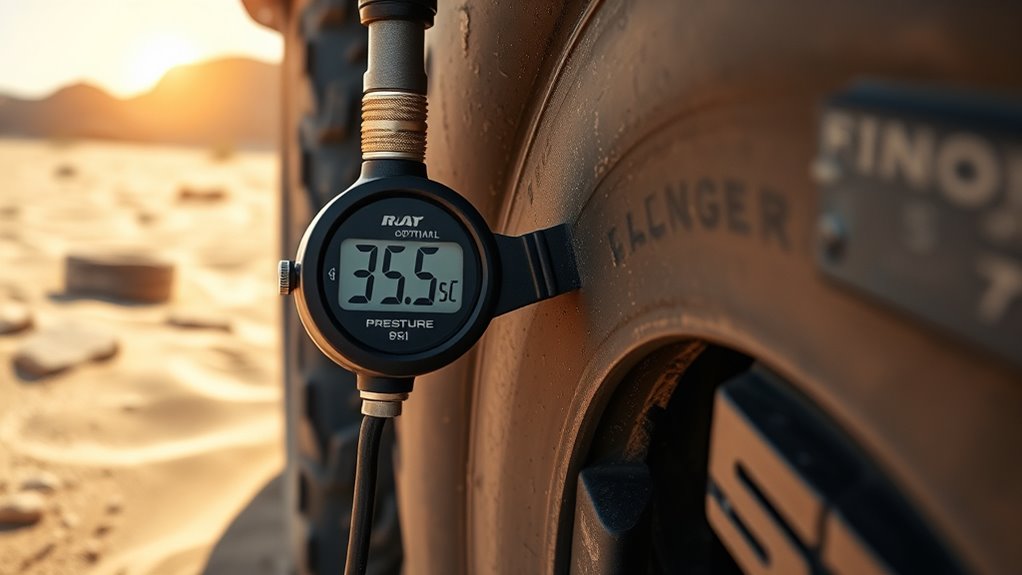
Achieving accurate tire pressure starts with using the right tools designed for precision and ease of use. A high-quality digital tire pressure gauge provides quick, reliable readings, reducing the chances of errors common with analog models. Make certain your gauge is calibrated regularly for consistent accuracy. A portable air compressor with a fine control valve allows you to add or release air precisely, especially useful during desert runs where conditions change rapidly. A tire pressure monitoring system (TPMS) can give you real-time data without stopping, saving valuable time. Additionally, keep a small, durable deflation tool for fine adjustments. Using these tools correctly ensures your tires are always at suitable pressure, enhancing safety, performance, and tire longevity during high-speed desert adventures.
Tips for Fine-Tuning Tire Pressures During a Desert Run
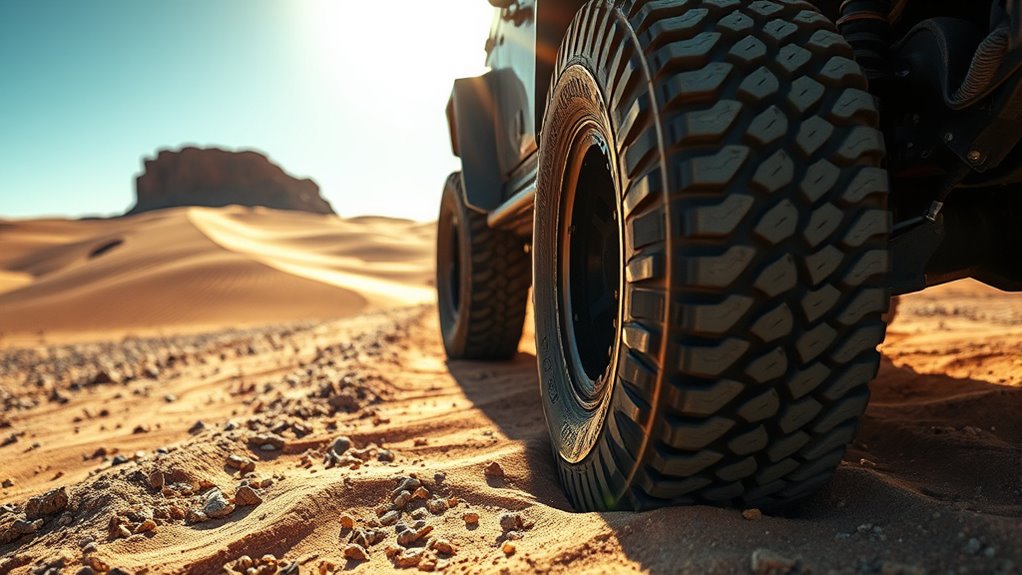
Fine-tuning your tire pressures during a desert run requires constant attention and quick adjustments. Pay close attention to how your tires feel and respond, especially as terrain changes. Regularly check your pressures with a reliable gauge, and don’t hesitate to make small, incremental adjustments. If you encounter loose sand, slightly lower your pressure for better flotation; on hardpack, raise it for stability. Keep an eye on your vehicle’s handling, as over- or under-inflation can affect control. To refine your pressures effectively, consider these tips:
Adjust tire pressures frequently during desert runs for optimal control and flotation.
- Monitor tire temperature regularly to gauge pressure changes
- Adjust pressures based on terrain shifts
- Use a portable compressor for quick inflations or deflations
- Record pressure changes for future reference
- Stay alert to vibrations or pulling that indicate pressure issues
Safety Considerations and Common Mistakes to Avoid
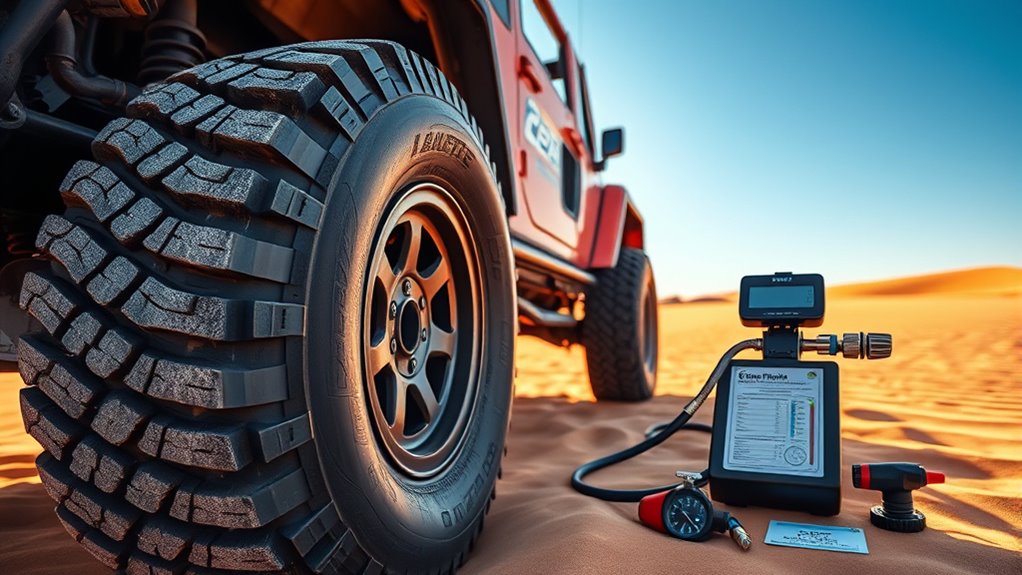
While adjusting tire pressures during a desert run is essential for performance, prioritizing safety is equally important. One common mistake is lowering pressures too much, which can cause tires to bead or come off the rim at high speeds. Always double-check your pressure gauges and avoid guesswork. Overestimating tire pressure can lead to poor traction and increased risk of blowouts. Remember to stay within the recommended range for your vehicle and conditions. Don’t ignore temperature changes; tire pressure can fluctuate considerably as tires heat up. Also, avoid sudden pressure adjustments during a run—make changes gradually to prevent damage. Ultimately, always carry a reliable air compressor and tools for quick adjustments, ensuring you can respond safely to unexpected issues.
Frequently Asked Questions
How Often Should Tire Pressures Be Checked During a Desert Run?
You should check your tire pressures frequently during a desert run, ideally every 30 minutes or after every few miles. Desert terrain can cause rapid pressure loss due to sharp rocks, hot temperatures, and rough surfaces. Regular checks guarantee your tires stay at the right pressure, preventing blowouts and maintaining traction. Carry a reliable air compressor or pump, and always monitor your tire pressure to stay safe and perform well.
Can Changing Tire Pressure Improve Fuel Efficiency in Desert Driving?
Changing your tire pressure can improve fuel efficiency in desert driving. When you lower pressure slightly, your tires gain more traction and absorb bumps better, reducing strain on your engine. Just make sure not to go too low, or you’ll risk tire damage. Regularly adjusting pressure based on terrain helps you optimize fuel use, making your desert runs more efficient and enjoyable. Always check your pressures before hitting rough terrains.
What Are Signs of Incorrect Tire Pressure While Off-Road?
Imagine your tires as the shoes of your vehicle—if they’re too tight or loose, discomfort follows. When off-road, incorrect tire pressure shows through poor handling, like slipping on loose sand or feeling unstable over rocks. You might notice uneven tire wear, decreased traction, or a softer ride. These signs tell you it’s time to check and adjust your tire pressure, ensuring your vehicle stays confident and steady on rugged terrains.
How Does Tire Pressure Affect Vehicle Handling on Loose Sand?
You’ll notice that lower tire pressure on loose sand improves your vehicle’s handling by increasing the tire’s surface area, which helps prevent sinking and offers better traction. If your pressure is too high, the tires won’t grip the sand well, making steering difficult and increasing the risk of getting stuck. Adjust your tire pressure appropriately—softer for loose sand—to maintain control and guarantee smoother, safer off-road adventures.
Are There Specific Tire Pressure Recommendations for Different Desert Terrains?
You should adjust your tire pressures based on the specific desert terrain you’re tackling. On soft, loose sand, lower pressures help improve traction and prevent sinking. For firmer, compacted surfaces, higher pressures provide better stability and control. Always consider the terrain’s firmness and your vehicle’s weight. It’s best to experiment safely and carry a reliable pressure gauge to fine-tune your tires for peak performance on each type of desert terrain.
Conclusion
Getting your tire pressure just right is like finding the perfect groove in a desert dance—too much or too little, and the rhythm’s off. By understanding how pressure affects performance, adjusting for load and speed, and using the right tools, you’ll stay in control when the sands shift beneath you. Remember, precision isn’t just a detail; it’s the secret to mastering the high-speed desert dance and conquering every mile with confidence.
